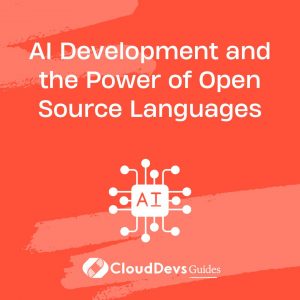AI Development and the Power of Open Source Languages
Artificial Intelligence (AI) has revolutionized countless industries, from healthcare and finance to transportation and entertainment. Its rapid growth is attributed, in large part, to the accessibility and power of open-source programming languages. This blog explores the fascinating world of AI development, highlighting the pivotal role open-source languages play in unleashing the potential of artificial intelligence. From the benefits of open-source languages to popular tools and real-world code samples, we’ll embark on an exciting journey into the realm of AI and open source.
1. The Rise of AI Development
Over the past decade, AI has evolved from a promising concept to a transformative reality. The ability of machines to learn from data and perform human-like tasks has captured the imagination of researchers, developers, and businesses alike. AI is at the core of innovations like natural language processing, image recognition, autonomous vehicles, and personalized recommendations. To bring these ideas to life, developers require robust, flexible, and efficient programming languages.
2. Understanding Open Source Languages
Open-source languages refer to programming languages whose source code is freely available to the public. Developers can study, modify, and distribute the code, fostering collaboration and knowledge-sharing across the community. The open-source philosophy has played a pivotal role in the growth of AI, allowing developers to build upon existing frameworks and tools while contributing their own enhancements. Some of the most widely used open-source languages in AI development are:
2.1 Python
Python stands as the reigning champion in the world of AI development. Its simplicity, readability, and extensive libraries make it an ideal choice for both beginners and seasoned developers. Libraries like NumPy, Pandas, TensorFlow, and PyTorch provide essential tools for data manipulation, mathematical computations, and building neural networks. Let’s take a look at a simple Python code sample for loading and preprocessing data:
python
import pandas as pd
# Load data
data = pd.read_csv("dataset.csv")
# Preprocess data
# Your preprocessing steps here
2.2 R
R is another popular open-source language that excels in statistical computing and data analysis, making it a favorite among data scientists. Its vast collection of packages, particularly in machine learning, enables developers to implement complex algorithms effortlessly. R’s data visualization capabilities are unmatched, making it an excellent choice for creating insightful graphs and charts. Here’s a snippet for creating a basic scatter plot using R:
R # Load required library library(ggplot2) # Sample data data <- data.frame(x = c(1, 2, 3, 4, 5), y = c(2, 3, 4, 5, 6)) # Create scatter plot ggplot(data, aes(x, y)) + geom_point()
3. Advantages of Open Source Languages in AI Development
3.1 Flexibility and Customization
Open-source languages offer unparalleled flexibility, allowing developers to customize algorithms, frameworks, and tools to suit their specific needs. This adaptability fosters innovation and experimentation, leading to groundbreaking advancements in AI.
3.2 Community Collaboration
The open-source community thrives on collaboration. Developers worldwide contribute to existing projects, share insights, and collectively work towards overcoming challenges. This collaborative spirit accelerates the pace of AI development and ensures a wide range of perspectives are considered.
3.3 Cost-Effectiveness
Using open-source languages significantly reduces development costs as there is no need to purchase expensive licenses. This affordability makes AI development accessible to startups, researchers, and developers with limited budgets.
4. Essential Tools for AI Development
4.1 TensorFlow
TensorFlow, an open-source machine learning framework developed by Google, has emerged as a cornerstone of AI development. Its computational graphs allow developers to create complex neural networks with ease. TensorFlow is widely used in image recognition, natural language processing, and speech synthesis. Here’s a code snippet demonstrating how to create a simple neural network using TensorFlow:
python
import tensorflow as tf
# Define the neural network
model = tf.keras.Sequential([
tf.keras.layers.Dense(64, activation='relu', input_shape=(input_size,)),
tf.keras.layers.Dense(10, activation='softmax')
])
# Compile the model
model.compile(optimizer='adam', loss='categorical_crossentropy', metrics=['accuracy'])
4.2 PyTorch
PyTorch is another popular open-source machine learning library known for its dynamic computational graph and ease of use. Developed by Facebook’s AI Research lab, PyTorch has gained traction in the research community for its flexibility and ability to work seamlessly with Python. Below is a simple PyTorch code snippet for creating a convolutional neural network (CNN):
python
import torch
import torch.nn as nn
import torch.nn.functional as F
# Define the CNN
class CNN(nn.Module):
def __init__(self):
super(CNN, self).__init__()
self.conv1 = nn.Conv2d(3, 16, 3, 1, 1)
self.fc1 = nn.Linear(16 * 32 * 32, 10)
def forward(self, x):
x = F.relu(self.conv1(x))
x = x.view(-1, 16 * 32 * 32)
x = self.fc1(x)
return x
5. Real-World Applications
5.1 Healthcare
AI-powered applications in healthcare are revolutionizing patient care, diagnosis, and treatment. From analyzing medical images to predicting disease outcomes, AI’s impact on the healthcare sector is profound. Open-source languages facilitate the development of AI tools that can assist doctors in making accurate and timely decisions.
5.2 Finance
The finance industry is leveraging AI to detect fraud, optimize investments, and predict market trends. By utilizing open-source languages, financial institutions can create custom AI solutions tailored to their specific needs, without compromising on security.
5.3 Autonomous Vehicles
The race to develop self-driving cars relies heavily on AI. Open-source languages enable researchers and companies to collaborate and share advancements in autonomous vehicle technology, ultimately accelerating the realization of this transformative innovation.
Conclusion
AI development is an exciting and fast-paced field that continues to shape the future in unimaginable ways. The power of open-source languages has been instrumental in propelling AI to new heights. With the flexibility, collaboration, and cost-effectiveness they provide, developers worldwide are empowered to create innovative AI solutions that impact every aspect of our lives. As we move forward, the synergy between AI and open source will undoubtedly continue to drive groundbreaking advancements, fueling the transformative potential of artificial intelligence.
Table of Contents









